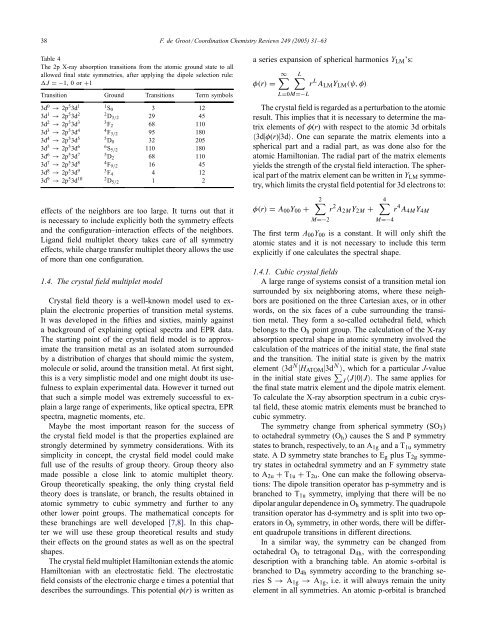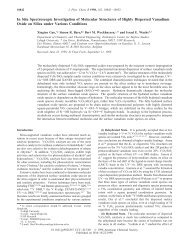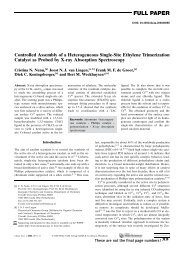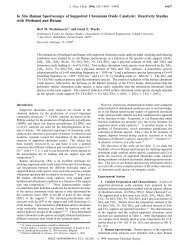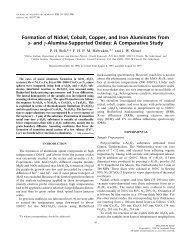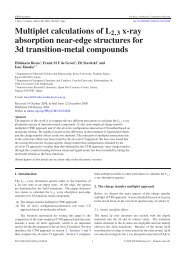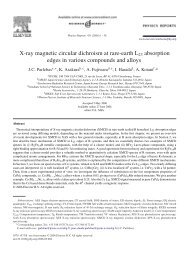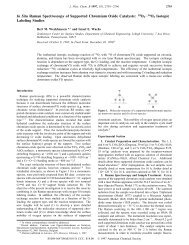Multiplet Effects in X-ray Absorption - Inorganic Chemistry and ...
Multiplet Effects in X-ray Absorption - Inorganic Chemistry and ...
Multiplet Effects in X-ray Absorption - Inorganic Chemistry and ...
Create successful ePaper yourself
Turn your PDF publications into a flip-book with our unique Google optimized e-Paper software.
38 F. de Groot / Coord<strong>in</strong>ation <strong>Chemistry</strong> Reviews 249 (2005) 31–63Table 4The 2p X-<strong>ray</strong> absorption transitions from the atomic ground state to allallowed f<strong>in</strong>al state symmetries, after apply<strong>in</strong>g the dipole selection rule:J =−1,0or+1Transition Ground Transitions Term symbols3d 0 → 2p 5 3d 1 1 S 0 3 123d 1 → 2p 5 3d 2 2 D 3/2 29 453d 2 → 2p 5 3d 3 3 F 2 68 1103d 3 → 2p 5 3d 4 4 F 3/2 95 1803d 4 → 2p 5 3d 5 5 D 0 32 2053d 5 → 2p 5 3d 6 6 S 5/2 110 1803d 6 → 2p 5 3d 7 5 D 2 68 1103d 7 → 2p 5 3d 8 4 F 9/2 16 453d 8 → 2p 5 3d 9 3 F 4 4 123d 9 → 2p 5 3d 10 2 D 5/2 1 2effects of the neighbors are too large. It turns out that itis necessary to <strong>in</strong>clude explicitly both the symmetry effects<strong>and</strong> the configuration–<strong>in</strong>teraction effects of the neighbors.Lig<strong>and</strong> field multiplet theory takes care of all symmetryeffects, while charge transfer multiplet theory allows the useof more than one configuration.1.4. The crystal field multiplet modelCrystal field theory is a well-known model used to expla<strong>in</strong>the electronic properties of transition metal systems.It was developed <strong>in</strong> the fifties <strong>and</strong> sixties, ma<strong>in</strong>ly aga<strong>in</strong>sta background of expla<strong>in</strong><strong>in</strong>g optical spectra <strong>and</strong> EPR data.The start<strong>in</strong>g po<strong>in</strong>t of the crystal field model is to approximatethe transition metal as an isolated atom surroundedby a distribution of charges that should mimic the system,molecule or solid, around the transition metal. At first sight,this is a very simplistic model <strong>and</strong> one might doubt its usefulnessto expla<strong>in</strong> experimental data. However it turned outthat such a simple model was extremely successful to expla<strong>in</strong>a large range of experiments, like optical spectra, EPRspectra, magnetic moments, etc.Maybe the most important reason for the success ofthe crystal field model is that the properties expla<strong>in</strong>ed arestrongly determ<strong>in</strong>ed by symmetry considerations. With itssimplicity <strong>in</strong> concept, the crystal field model could makefull use of the results of group theory. Group theory alsomade possible a close l<strong>in</strong>k to atomic multiplet theory.Group theoretically speak<strong>in</strong>g, the only th<strong>in</strong>g crystal fieldtheory does is translate, or branch, the results obta<strong>in</strong>ed <strong>in</strong>atomic symmetry to cubic symmetry <strong>and</strong> further to anyother lower po<strong>in</strong>t groups. The mathematical concepts forthese branch<strong>in</strong>gs are well developed [7,8]. In this chapterwe will use these group theoretical results <strong>and</strong> studytheir effects on the ground states as well as on the spectralshapes.The crystal field multiplet Hamiltonian extends the atomicHamiltonian with an electrostatic field. The electrostaticfield consists of the electronic charge e times a potential thatdescribes the surround<strong>in</strong>gs. This potential φ(r) is written asa series expansion of spherical harmonics Y LM ’s:φ(r) =∞∑L∑L=0M=−Lr L A LM Y LM (ψ, φ)The crystal field is regarded as a perturbation to the atomicresult. This implies that it is necessary to determ<strong>in</strong>e the matrixelements of φ(r) with respect to the atomic 3d orbitals〈3d|φ(r)|3d〉. One can separate the matrix elements <strong>in</strong>to aspherical part <strong>and</strong> a radial part, as was done also for theatomic Hamiltonian. The radial part of the matrix elementsyields the strength of the crystal field <strong>in</strong>teraction. The sphericalpart of the matrix element can be written <strong>in</strong> Y LM symmetry,which limits the crystal field potential for 3d electrons to:φ(r) = A 00 Y 00 +2∑r 2 A 2M Y 2M +M=−24∑r 4 A 4M Y 4MM=−4The first term A 00 Y 00 is a constant. It will only shift theatomic states <strong>and</strong> it is not necessary to <strong>in</strong>clude this termexplicitly if one calculates the spectral shape.1.4.1. Cubic crystal fieldsA large range of systems consist of a transition metal ionsurrounded by six neighbor<strong>in</strong>g atoms, where these neighborsare positioned on the three Cartesian axes, or <strong>in</strong> otherwords, on the six faces of a cube surround<strong>in</strong>g the transitionmetal. They form a so-called octahedral field, whichbelongs to the O h po<strong>in</strong>t group. The calculation of the X-<strong>ray</strong>absorption spectral shape <strong>in</strong> atomic symmetry <strong>in</strong>volved thecalculation of the matrices of the <strong>in</strong>itial state, the f<strong>in</strong>al state<strong>and</strong> the transition. The <strong>in</strong>itial state is given by the matrixelement 〈3d N |H ATOM |3d N 〉, which for a particular J-value<strong>in</strong> the <strong>in</strong>itial state gives ∑ J 〈J|0|J〉. The same applies forthe f<strong>in</strong>al state matrix element <strong>and</strong> the dipole matrix element.To calculate the X-<strong>ray</strong> absorption spectrum <strong>in</strong> a cubic crystalfield, these atomic matrix elements must be branched tocubic symmetry.The symmetry change from spherical symmetry (SO 3 )to octahedral symmetry (O h ) causes the S <strong>and</strong> P symmetrystates to branch, respectively, to an A 1g <strong>and</strong>aT 1u symmetrystate. A D symmetry state branches to E g plus T 2g symmetrystates <strong>in</strong> octahedral symmetry <strong>and</strong> an F symmetry stateto A 2u + T 1u + T 2u . One can make the follow<strong>in</strong>g observations:The dipole transition operator has p-symmetry <strong>and</strong> isbranched to T 1u symmetry, imply<strong>in</strong>g that there will be nodipolar angular dependence <strong>in</strong> O h symmetry. The quadrupoletransition operator has d-symmetry <strong>and</strong> is split <strong>in</strong>to two operators<strong>in</strong> O h symmetry, <strong>in</strong> other words, there will be differentquadrupole transitions <strong>in</strong> different directions.In a similar way, the symmetry can be changed fromoctahedral O h to tetragonal D 4h , with the correspond<strong>in</strong>gdescription with a branch<strong>in</strong>g table. An atomic s-orbital isbranched to D 4h symmetry accord<strong>in</strong>g to the branch<strong>in</strong>g seriesS → A 1g → A 1g , i.e. it will always rema<strong>in</strong> the unityelement <strong>in</strong> all symmetries. An atomic p-orbital is branched


